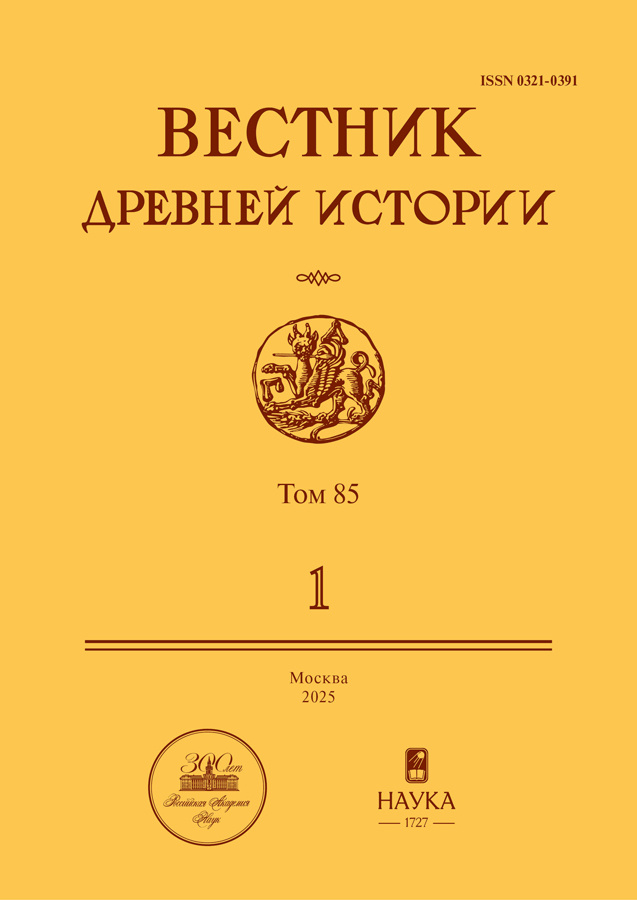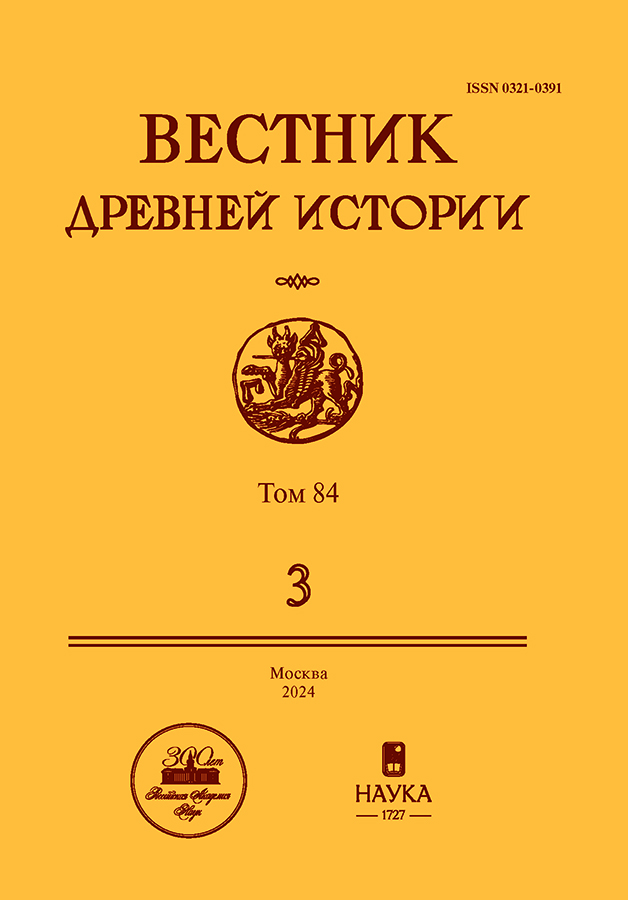Shalmaneser I in Šināmu: on two aspects of a new Middle Assyrian royal inscription from Üçtepe
- Authors: Alexandrov B.E.1
-
Affiliations:
- HSE University
- Issue: Vol 84, No 3 (2024)
- Pages: 597-610
- Section: Articles
- URL: https://rjmseer.com/0321-0391/article/view/682333
- DOI: https://doi.org/10.31857/S0321039124030016
- ID: 682333
Cite item
Abstract
The article analyzes the historical context of the inscription of Shalmaneser I from Üçtepe published in 2022. At the end of Adad-nērārī I’s reign (1295–1264) and in the early years of Shalmaneser I (1263–1234), the city of Šināmu, now identified with Üçtepe, was controlled by the kingdom of Hanigalbat, as it is shown by the letter IBoT 1.34 from the Boǧazköy archives. According to IBoT 1.34, a certain ruler of Hanigalbat resided in Šināmu not long before the time when this text was composed. A presence in person of the king of Hanigalbat in Šināmu, a city on the Upper Tigris, far from the major centers of his land in the Habur triangle and in a close proximity to the Hittite border, reflects a tense situation on the eve of the Assyrian attack, when Hanigalbat was balancing between two powerful neighbors. A possible mention of the conquest of Carchemish by Assyria needs to be confronted with the evidence provided by KBo 18.25+ and KBo 18.28+, two other letters from the Boǧazköy archives. This evidence provided by the Üçtepe inscription supports previously advanced hypotheses about a major Hittite-Assyrian military clash during the reign of Shalmaneser I.
Keywords
Full Text
About the authors
Boris E. Alexandrov
HSE University
Author for correspondence.
Email: boris_alexandrov@icloud.com
ORCID iD: 0000-0001-7295-0628
кандидат исторических наук, доцент
Russian Federation, MoscowReferences
- Akkermans, P., Wiggermann, F. 2015: West of Aššur: The Life and Times of the Middle Assyrian Dunnu at Tell Sabi Abyad, Syria. In: B. S. Düring (ed.), Understanding Hegemonic Practices of the Early Assyrian Empi re. Essays Dedicated to Frans Wiggermann . (Publiсations de l’Institut historique-archéologique néerlandais de Stamboul, 125). Leiden, 89 – 123.
- Alexandrov, B. 2010: [The Hittite Kingdom and the Upper Mesopotamian States in the Reign of Tudhaliya IV and His Sons (2 nd Half of the 13 th — Beginning of the 12 th Century B. C.): New Hypotheses and Sources]. Vestnik dre vney istorii [ Journal of Ancient History ] 4, 112 – 132.
- Александров, Б. Е. Хеттское царство и страны Верхней Месопотамии в правление Тудхалии IV и его сыновей (2-я половина XIII — начало XII в. до н. э.): новые гипотезы и источники. ВДИ 4, 112 – 132.
- Alexandrov, B. 2014: The Letters from Hanigalbat in the Boğazköy Archives. In: P. Taracha (ed.), Proceedings of the Eighth International Congress of Hi ttitology, Warsaw, 5 – 9 September 2011 . Warsaw, 51 – 76.
- Alexandrov, B. 2023: On the Fate of Šinamu in the 13 th Century B. C. Nouvelle s assyriologiques br èves et utilitaires 4, 179 – 180.
- Alexandrov, B., Sideltsev, A. 2009: Hittite āššweni . Revue d ’assyriologie et d’archéologie ori entale 103, 59 – 84.
- Bloch, Y. 2010: The Order of Eponyms in the Reign of Tukultī-Ninurta I. Orientalia 79, 1 – 35.
- Cancik-Kirschbaum, E. 1996: Die mitt elassyrischen Briefe aus Tall Šē ḫ Ḥ amad . (Berichte der Ausgrabung Tall Šē ḫ Ḥ amad / Dūr-Katlimmu, 4/1). Berlin.
- Cancik-Kirschbaum, E., Hess, Chr. 2016: Toponyme der mittelassyrischen Texte: Der W esten des mittelassy rischen Reiches . (Matériaux pour l’étude de la toponymie et de la topographie, I/2). Antony.
- Cohen, Y., Torrecilla, E. 2020: Forging an Empire: The Borders of the Land of Karkemiš According to the Treaty between Šuppiluliuma and Šattiwaza. Tel Aviv 47, 193 – 207.
- De Martino, S. 2012: La lettera IBoT 1.34 e il problema dei sincronismi tra Ḫa tti e Assiria nel XIII secolo a.C. In: G. Lanfranchi, D. Morando Bonacossi, C. Pappi, S. Ponchia (eds.), Leggo! Studies Presented to Frederick Mario Fales on the Occasion of His 65th Birthday . (Leipziger Altorientalistische Studien, 2). Wiesbaden, 195 – 200.
- De Ridder, J.J. 2023: A Re-evaluation of the Assyrian Letter A 1587. State Archives of Assyria Bulleti n 29, 1 – 5.
- Del Monte, G.F., Tischler, J. 1978: Die Orts- und Gewässernamen der hethitischen Texte . (Répertoire géographique des textes cunéiformes, 6). Wiesbaden.
- Freu, J. 2003: Histoire du Mitanni . Paris.
- Freu, J., Mazoyer, M. 2009: Le déclin et la chute du Nouvel Empire hitt ite. Les Hittites et leur histoire . Paris.
- Genç, B., MacGinnis, J. 2022: A Text of Shalmaneser I from Üçtepe and the Location of Šinamu. Anatolian Studies 72, 79 – 95.
- Grayson, A.K. 1987: Assyrian Rulers of the Third a nd Second Millennia BC (to 1115 BC) . (Royal Inscriptions of Mesopotamia, Assyrian Periods, 1). Toronto–Buffalo–London.
- Harrak, A. 1987: Assyria and Hanigalbat. A Histo rical Reconstruction of Bilateral Relati ons from the Middle of the Fourteenth to the End of the Twelfth Centuries B. C . (Texte und Studien zur Orientalistik, 4). Hildesheim–Zürich–New York.
- Jakob, S. 2007: Diplomaten in Assur — Alltag oder Anzeichen für eine internationale Krise? In: P. A. Miglus, J. Córdoba (Hrsg.), Assur und sein Umland. Im Andenken an die ersten Ausgräber d es Assur . (Isimu, 6). Madrid, 103 – 114.
- Jakob, S. 2009: Die mit telassyrischen Texte aus Tell Chuēra in Nordost-Syrien . (Vorderasiatische Forschungen der Max Freiherr von Oppenheim-Stiftung, 2/III). Wiesbaden.
- Kessler, K. 1980: Untersuchungen zur historischen Topographie Nordmeso potamiens nach keils chriftlichen Quellen des 1. Jahrtausends v. Chr . (Tübinger Atlas des Vorderen Orients, B/26). Wiesbaden.
- Klengel, H. 1963: Zum Brief eines Königs von Ḫ anigalbat (IBoT I 34). Orientalia 32, 280 – 291.
- Kühne, C. 1995: Ein mittelassyrisches Verwaltungsarchiv und andere Keilschrifttexte. In: W. Ortmann, R. Hempelmann, H. Klein, C. Kühne, M. Novak, A. Pruss, E. Vila, H.-M. Weicken, A. Wener (Hrsg.), Ausgrabungen in Tell Chuē ra in Nordost-Syrien , I. Vorbericht über die Grabung skampagnen 1986 – 1992 . Saarbrücken, 205 – 225.
- Miller, J. 2010: Revisiting the Conquest of Karkamiš of Mursili’s 9 th Year: Assyrian Aggression or Mursili in the Long Shadow of His Father? In: J. Fincke (Hrsg.), Festschrift für Gernot Wilhelm anläßlic h seines 65. Geburts tages am 28. Januar 2010 . Dresden, 235 – 239.
- Mora, C., Giorgieri, M. 2004: Le lettere tra i re ittiti e i re assiri ritrovate a Ḫ attuša . (History of the Ancient Near East, Monographs, VII). Padova.
- Nemirovsky, A.A., Alexandrov, B.E. 2007: « Na Solntse, otsa m oego, ya polagayus’»: IBoT I 34 i istoriya Verkh ney Mesopotamii v XI II v. do n. e. [ “In the Sun , My Father, I Trust”: IBoT I 34 and the History of the Upper Mesopotamia in the 13 th Century B. C.E. ]. Moscow.
- Немировский, А.А., Александров, Б.Е. « На Солнце, отца моего, я полагаюсь »: IBoT I 34 и история Верхней Ме сопотамии в XIII в. до н. э . М.
- Nikolaev, A. 2021: New Phrygian (-)τετικμενος, Hittite tekri and other descendants of PIE *dei ̯ḱ -*. Chatreššar 4/2, 41–56.
- Shibata, D. 2017: An Expedition of King Shalmaneser I and Prince Tukultī-Ninurta to Carchemish. In: Y. Heffron, A. Stone, M. Worthington (eds.), At the Dawn of History. Ancient Near Eastern Studies in Honour of J. N. Postgate . Vol. 1. Winona Lake, 491 – 506.
- Singer, I. 2003: The Great Scribe Taki-Šarruma. In: G. Beckman, R. Beal, G. McMahon (eds.), Hittite Studies in Honor of Harry H. Hoffner Jr . on the Occasion of His 65 th Birthday . Winona Lake, 341 – 348.
- Singer, I. 2008: A Hittite-Assyrian Diplomatic Exchange in the Late 13 th Century BCE. In: A. Archi, R. Francia (eds.), VI Congresso Internazionale di Ittitologia. Roma, 5 – 9 settembre 2005 . (Studi micenei ed egeo-anatolici, 50). Roma, 713 – 720.
- Yamada, M. 2011: The Second Military Conflict between ‘Assyria’ and Ḫ atti in the Reign of Tukulti-Ninurta I. Revue d’assyriologie et d’arché ologie orientale 105, 199 – 220.
- Ziegler, N., Langlois, A.-I. 2016: Les toponymes des textes paléo-ba byloniens . (Matériaux pour l’étude de la toponymie et de la topographie, I/1). Antony.
Supplementary files











